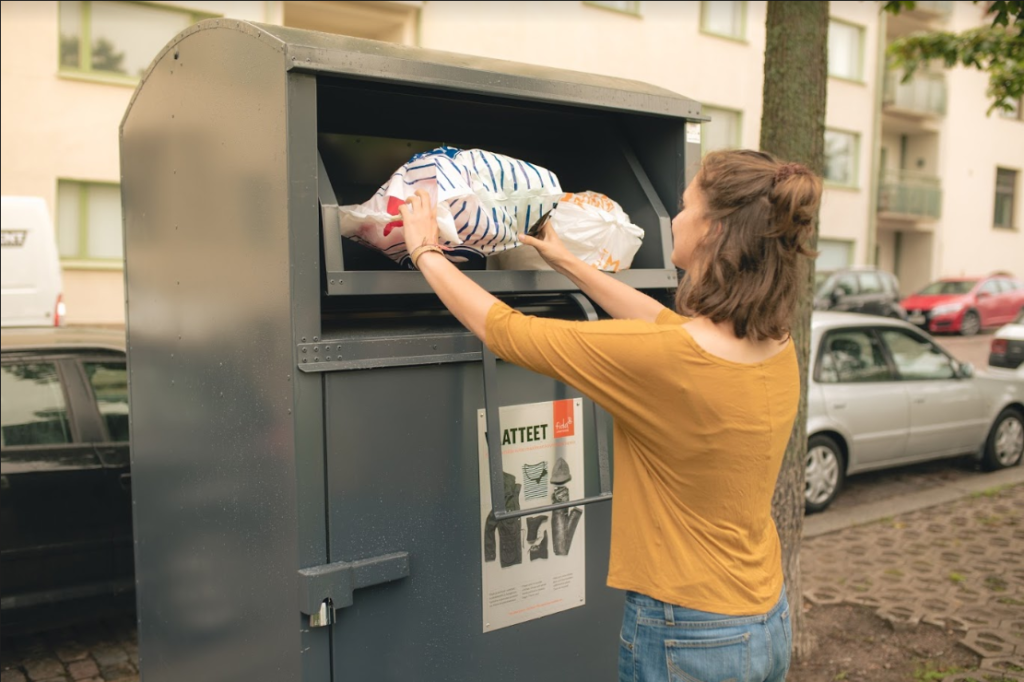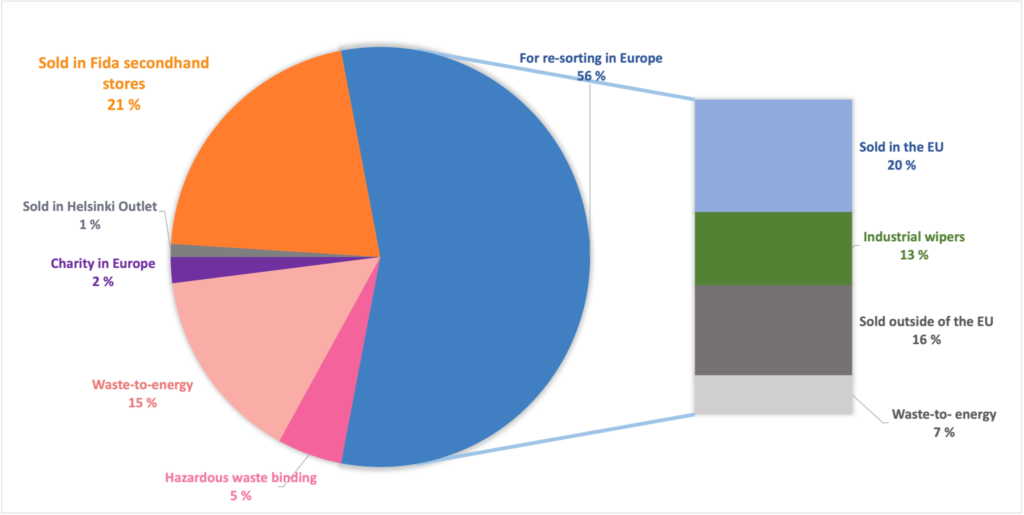Where do donated clothes end up?

Finns donated 1,25 million kilos of textiles during year 2020 to Fida. What happens to donated goods?
The donated clothes were sorted into three categories:
- 21% were I-quality clothes sold in Fida secondhand Shops in Finland
- 58% were II-quality clothes, not fit for local sale. Most of it was sold for re-sorting to partners in the EU, a part was donated to charity, and the rest was sold in Fida’s outlet.
- 15% was converted to energy. This third category included clothes that were dirty, wet, or otherwise unable to be used anymore. II-quality clothes that for some reason were not able to be sold or donated were also utilised as energy.
- 4% was used as a binding agent for hazardous waste processing.
What is the purpose behind Fida secondhand chain’s work?
Fida secondhand has been one of the largest secondhand chains in Finland for over 40 years. We thank everyone who has donated for Fida secondhand!
Fida’s history dates back to 1979, when the first LKA store (Fida’s former name) was opened in Sörnäinen, Helsinki. Today, Fida secondhand has 22 shops and one outlet in Finland.
Giving new life to donated clothes, furniture and other items is the heart of Fida secondhand’s operation. The profits from our secondhand stores are used for providing a better life for the world’s poorest people abroad by our missions- and development cooperation organization Fida International.
How Fida sorts donated clothes?
In Helsinki region clothes are sorted in Fida’s sorting facility in Helsinki. Rest of the clothes are sorted locally in Fida secondhand shops outside the capital region. Fida sorts around 1.5 million kilos of clothes per year.
Donated clothes are sorted into three categories. 20-30% of donated clothes are I-quality clothes sold in Fida secondhand Shops in Finland and 60-75% are II-quality clothes, not fit for local sale. 5-10% of donated clothes are dirty, wet, in bad condition or otherwise unable to be used anymore. These end up being burned in waste-for-energy power plants.
Fida aims to continuously develop its processes and operations, in order to best take advantage of all received donations. We aim to use all received clothes as clothes and not burn them in waste-for-energy power plants.
How much did Fida recycle in 2020?
In 2020 1,25 million kilos of clothes were donated to Fida secondhand. 21% were I-quality clothes sold in Fida secondhand Shops in Finland. 58% were II-quality clothes, not fit for local sale, most of it was sold for re-sorting to partners in the EU, a part was donated to charity, and the rest was sold in Fida’s outlet.
Like other secondhand chains in Finland, Fida secondhand does not have the resources or equipment to efficiently recycle textile waste. Therefore, it is vital that donations are fit for resale and are packed properly in closed plastic bags to keep them from getting wet, dirty or damaged. In the worst–case scenario, a garment that is dirty or wet ends up being burned in waste-for-energy power plants – something that is expensive for Fida and other charities alike. In 2020 15% of donations were converted to energy.
Where were the donated clothes utilized?
Most of the donations (84%) were utilized either as clothing or raw material in Finland or in the EU. The donated garments that did not end up being sold in Finland were sold to partners in the EU (56 % of the donations) or were donated to charity inside the EU (2 % of the donations). Fida donates clothing to several select projects, such as to Eastern European villages as part of the Toivon Kipinä Christmas campaign. Fida also donated clothing to Hämeen Mokia ry, Asaria ry and small churches inside the European Union. These organizations and churches distribute clothes to needy people in Finland, the Baltic countries, and parts of Eastern Europe.
What happens in re-sorting? How many of donated clothes can end outside of Europe?
Fida’s wholesale partners utilize the donated textiles that are not fit for sale in Finland. Fida prefers partners that emphasize textile recycling. These partners focus on producing industrial towels and wipers from poor-condition clothing, and local resale of good-condition clothing. Fida carefully selects its wholesale partners in the EU. Before starting cooperation, Fida collects information on the prospective partner – data relating to the partner’s processes and operations, certification, waste management, and resale practices.
After receiving the textiles, the partners sort the clothes once again. Some of the textiles are sold locally, others are sold wholesale to other European countries. Textiles with poor resale value are transformed into towels or wipers meant for industrial use or are recycled in some other way. A small portion, 9-15% of the donated garments, continue to countries outside of Europe.
Fida primarily works with wholesale partners that sort, refine and sell textiles locally, inside the EU. However, these partners have finite capacity, and cannot process all the textiles which Fida has to offer. For this reason, Fida also works with European partners that have broader global networks. In 2020 approximately 16% of donated clothes ended up outside EU.
It is important to Fida that these partners follow EU regulations, which ensures that the textiles are processed in safe and humane conditions and facilities, and that waste is handled in an environmentally friendly way.
Fida aims to continuously develop its processes and operations, in order to best take advantage of all received donations. We aim to use all received clothes as clothes and not burn them in waste-for-energy power plants.
Fida has started a process which examines the sorting and resale activities of all current European partners and seeks to find new partners who do not sell clothing outside the EU at all.
Why is donating poor-condition clothing to charity not a good idea?
Why is it so expensive to sort textiles?
Around 72 million kilos of textiles are recycled or thrown out each year in Finland. As cheap fashion grows popularity, so does the portion of donated clothing that not fit for resale and must be disposed of.
For charity organizations, garments that are not fit for resale create a lot of extra cost in the form of waste management fees. People might donate dirty or worn-out clothes without realizing that charity organizations cannot utilize these. The extra costs incurred by handling this type of clothing means less money for Fida International’s core charity operations.
The sorting of rags is time-consuming and expensive, as each sorted item needs to be reviewed by hand. Sorting of clothes is professional work; thus, Fida has trained qualified, experienced sorters who have an eye for the sorting of donations – they make the decision if a garment is fit for sale or not.
2020 in numbers
The donated clothes were sorted into three categories:
- 21% were I-quality clothes sold in Fida secondhand Shops in Finland
- 58% were II-quality clothes, not fit for local sale. Most of it was sold for re-sorting to partners in the EU, a part was donated to charity, and the rest was sold in Fida’s outlet.
- 15% was converted to energy. This third category included clothes that were dirty, wet, or otherwise unable to be used anymore. II-quality clothes that for some reason were not able to be sold or donated were also utilised as energy.
- 4% was used as a binding agent for hazardous waste processing.

More information:
Here you can read more about how to donate goods to Fida secondhand. Outi Pyy, a Finnish influencer of sustainable fashion, has also written a blog post on this subject (in Finnish only).
